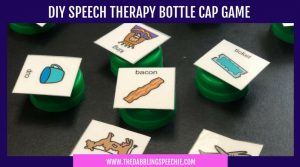Everyday objects as Speech Toys: Bottle Caps
Everyday objects as Speech Toys: Bottle Caps
If you are looking for new and creative ways to facilitate speech and language development, you can do this right at home. You don’t need to get all those pricey toys from the best of the stores. Instead, you can use everyday objects in speech therapy. One such item that we are going to discuss further is bottle caps and how they can be used to facilitate speech development.
Collecting the bottle caps: Make sure you get clean & sanitized bottle caps of any kind. You can use soda bottles, water bottle caps etc. Ask your family or friends to collect some caps if you do not drink beverages from packaged bottles. You will need to collect around 20-30 of these bottle caps for the activities.
Velcro attachments: You can cut the Velcro pieces into small squares that fit on the bottle cap. You can then stick one piece on the cap & the other part on the picture. In this way, you can choose whichever picture you want & just stick them on the bottle caps using Velcro. When you need another picture, just rip off the picture & attach the other one.
Following are some activities that can be done at home to improve on speech & language skills:
1. Colour matching & identification
For this activity, you will need different colours of bottle caps. For the matching game, you will need to have at least 2 caps of each colour. You can use these to match colours with your child. Next, you can segregate the bottle caps based on colours & can match the cap with other objects in the house as well. Further, you can start naming each colour & as you name them, put them in the basket.
2. Labelling category groups
You can use any category that you want to work on with your child. For example, body parts. What you can do is, you can print out some body parts like eyes, nose, mouth, teeth, ears, hands, legs etc. on paper. Cut out these individual body parts. You can then match the body parts on the bottle caps with the ones on your body or your child’s body. You can also use them when you read/play stories about body parts for better understanding. Later, you can ask your child to label the body parts as you point out to them.
3. Answering open-ended questions
Different kind of “Wh” questions can be used in the activities. “Who”, “What”, “When” and “Where” are some of the questions that can be used to elicit speech. You can use the bottle caps with different categories and use the questions “What is this?” Your child then has to name the picture on the bottle cap. You can also ask other related questions like “Who is wearing red today, just like the red apple?” There are endless ways in which you can ask these questions. Being creative will help you use more questions in the activity.
4. Increasing utterance length
Consider this situation where your child is speaking at the one-word level. You can use these bottle cap activities to improve on utterance length. Pick up any activity that your child is doing. For example, they are eating ice cream & your child knows to say “Ice cream”. You can then model the words “Eating Ice cream” by using the bottle caps. For eating you can have your child’s picture of eating & for ice cream you can have any picture of ice cream on the bottle cap. Join the two words together, just like how you would say it. And then you can say, “Oh you love eating ice cream!” & point to the bottle caps at the same time. You can then expect your child to imitate it after you.
5. Conversational turn-taking
In this activity, you can pile up all the bottle caps in a basket or a box. You and your child can pick up a bottle cap alternately. Every time you pick up a bottle cap, you can talk about the picture on the bottle cap. Talk about what you see, what colour it is, where you can see it in the house etc. Then help your child choose a bottle cap & let them start describing the picture on the bottle cap. You can then take turns in picking up the bottle caps.
Everyday Items as Awesome Toys: Bottles
- Tips to Promote School Readiness - February 28, 2023
- Baby Sign Language - February 24, 2023
- Summer Speech Activities for Children - February 21, 2023



Leave a Comment
(0 Comments)